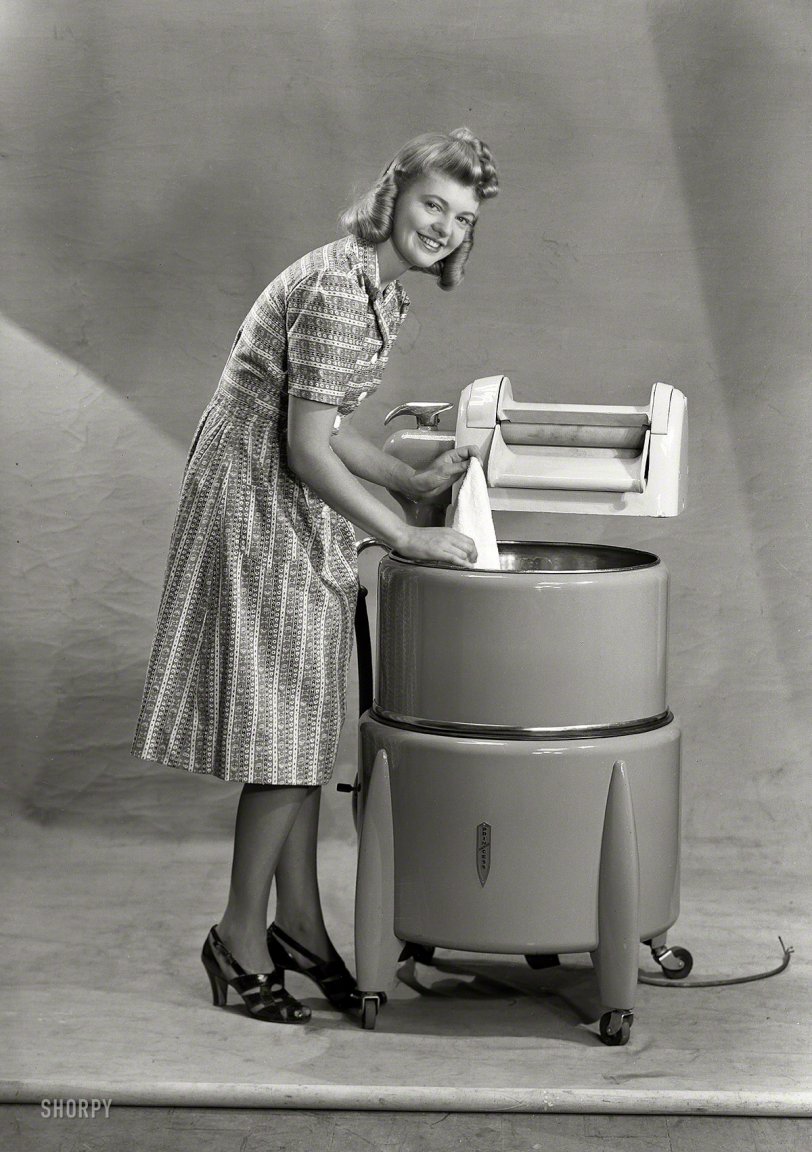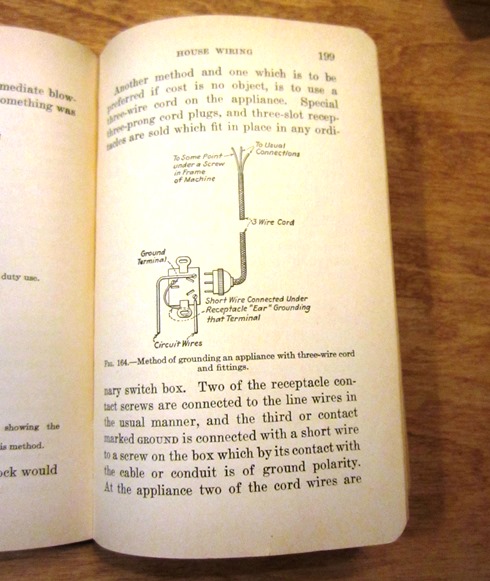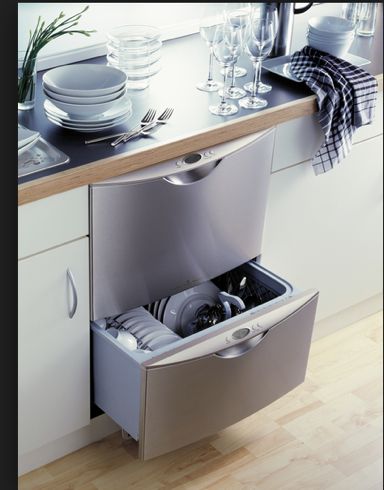


Framed or unframed, desk size to sofa size, printed by us in Arizona and Alabama since 2007. Explore now.
Shorpy is funded by you. Patreon contributors get an ad-free experience.
Learn more.

- Baldwin 62303
- Baldwin VO-1000
- Cold
- No expense spared
- Tough Guys
- Lost in Toyland
- And without gloves
- If I were a blindfolded time traveler
- Smoke Consumer Also Cooks
- Oh that stove!
- Possibly still there?
- What?!?
- $100 Reward
- Freeze Frame
- Texas Flyer wanted
- Just a Year Too Soon
- WWII -- Replacing men with women at the railroad crossing.
- Yes, Icing
- You kids drive me nuts!
- NOT An Easy Job
- I wonder
- Just add window boxes
- Icing Platform?
- Indiana Harbor Belt abides
- Freezing haze
- Corrections (for those who care)
- C&NW at Nelson
- Fallen Flags
- A dangerous job made worse
- Water Stop
Print Emporium
Princess Unplugged: 1950

New Zealand circa 1950s. "Model with wringer washing machine." I am Woman, see me Wash. Photo by Gordon Burt Studio. View full size.
Colour of the tub
I remember seeing machines like this in the second-hand shops and the colour always seemed to be middle-of-the-range green. Not dark green or pale green but somewhere in the middle.
That's settled
Now that the plug explanation has been crowd-sourced, what color would that magnificent contraption be? It predates the fad for avocado or harvest gold appliances, but even in grey scale, it's pretty clear that the tub is not "refrigerator white."
Why bother
We owned one of these dang things when I was a kid, my mom didn't need a plug on hers either because it was easier to go to the laundromat!
Plugless Princess
Lack of standardization of international electrical socket configurations and standards at the time led some manufacturers to ship their machines without plugs. It was the responsibility of the local installing dealer to provide a compatible one, be it with round pins, parallel or non-parallel flat blades, polarized or whatever. Also, jumpers in a junction box inside the machine often had to be changed to match local line voltages or 120 or 220 and frequencies of 25, 50 or 60 Hz. Not having a plug on the machine was an attempt to insure it would get properly setup by someone who knew what they were doing (although it didn't stop resourceful 10 year old boys from taking a lot of things for pre-installotion test drives).
Mom's warning
I can still remember my mother telling me in no uncertain terms not to put my fingers anywhere near the wringer and that was probably 62 years ago.
Plugs might not have been standardized
I seem to recall on an electrician's forum several years ago, that one Australian had dug up some documents showing that their standard plug only dated to 1938 (and it is well-documented to be originally an American design). Australia and New Zealand now share the same electrical standards, but I don't know if this was true in the '50s. Even today, I think many appliances in the UK require the user to install their own plug (witness the Tenth Doctor Who describing Donna Noble as someone who "can't even change a plug").
A benefit of waiting so late is that the need for grounding appliances was already evident. I have a 1930 American book warning of the special hazard of not grounding washing machines, and recommending using a plug that matches today's Australia/New Zealand plug. This advice was not officially sanctioned until 1947, and went mostly unheeded until 1962.

Standards are great, there are so many to choose from
It's just barely possible that sockets and plugs weren't as standardized in 1950s New Zealand as they are today. It may have made sense to ship appliances with no plug, and let the dealer or customer install the right plug to match the customer's house.
An example from another country: The UK officially switched to their current plugs and sockets right after WWII, but the previous standards remained in use. For a while it was *illegal* to sell an appliance wthere ith a plug on the cord - the theory was that if somebody bought an appliance with the wrong plug for their socket, they would just chop the plug off, leaving a plug with a bit of wire sticking out the end. A small child would then find this plug+wire, somehow find a matching socket, plug in the plug+wire, and zap themselves. In theory, anyway. Part of the regular school curriculum was "how to wire a plug".
Customer Supplied
Various options exist for the connection of electrical equipment, especially in earlier days or across different regions. Existing outlets of different ratings will have different plug configurations. Direct hard wiring of larger appliances is sometimes used with a disconnect switch that is surface mounted on the wall. The customer or installer would buy and attach the appropriate cord cap to match a particular location or existing outlets.
No plug ?
In some countries,like the UK, there was no one standard electrical outlet as in North America. Appliances were supplied with no plug, so that the user could supply the one that fit their particular outlets.
Tesla
It worked on the Tesla principle he invented where electricity was broadcast through the air.
Safety first
No plug on the cord insured that the that pretty lady didn't get any part of her pretty self caught in the wringer.
Kiwi Kitchen
The high end kitchen appliance manufacturers Fisher and Paykel is a New Zealand based company. They developed the "kitchen drawer" dishwasher.

Danger: Electrocution hazard!
Unplugged?!? There's not even a plug on the end of the cord. Her hairstyle could undergo a radical transformation when she pushes those wires into the wall socket.
This will work much better
If you have the power cord end attached.
That washer won't wash.
Is there some sort of world wide conspiracy to sell washers without a $#@% electrical plug attached to the power cable?
Pretty model.
Three wire
Obviously she won't get much washing done with the cord hanging loose like that, but I see that at least she will be protected from electrocution once they get the thing properly wired up.
One of the wheels is bent
Poor machine must have had a hard life.
A Bit Ahead of its Time
Must have been invented before wall outlets and plugs on cords. But at least it's not gasoline-powered like the one my grandmother had. As a kid of six, I spent a summer with her and laundry day was a noisy outdoor affair with the old one-banger. Primitive as it was, it was the once convenience Grandma had. The whites got boiled over a wood fire in an old cauldron with "bluing". This young woman looks like a twin for my niece, but thankfully my niece got a new washer and dryer just yesterday.
Princess Indeed
It blows my mind to think of doing laundry (even with today's machines!) in a dress, stockings and heels. Oh and with my hair curled.
[Princess is, for those who have not zoomed in, the brand of the machine. - Dave]

New Zealand Laundry
New Zealanders must be quite eccentric to be able to wash clothes in an unplugged washing machine. Either that or they are much smarter than the rest of us to have figured out how to get the machine to work without plugging it in.
Me being picky
I'm sure she'll get better performance out of the machine, when there's a plug on the end of the cord - and it's plugged into a socket.
[I guess no one noticed the title of this post. - Dave]
Yep, a point too subtle (for me) at that time of the morning.
Lucky Girl
Men in the Western civilization have always spoiled our women by allowing them to have electric appliances, educating them, and allowing them to carry their own money.
Something vital is missing
She will be able to get a lot more done if the washer was connected. Why no plug, and just an unterminated cord?
Perhaps it is the precursor to inductive charging.
Something missing.
There is no plug on the washing machine. Kind of hard to wash clothes without one.
























On Shorpy:
Today’s Top 5